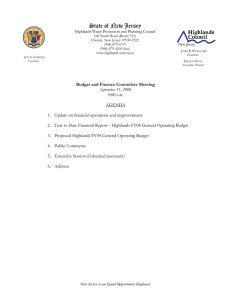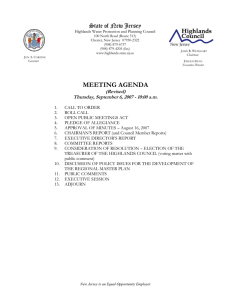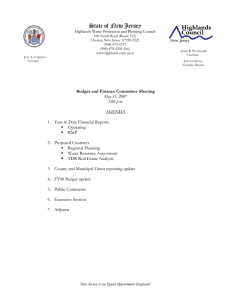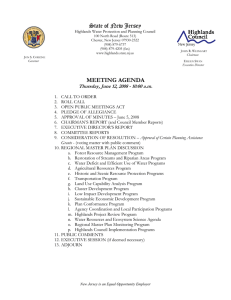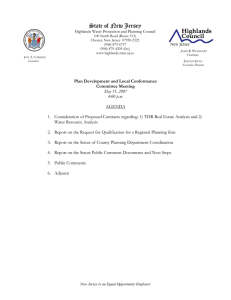Highlands Council Releases Regional Build Out Analysis State of New Jersey
advertisement
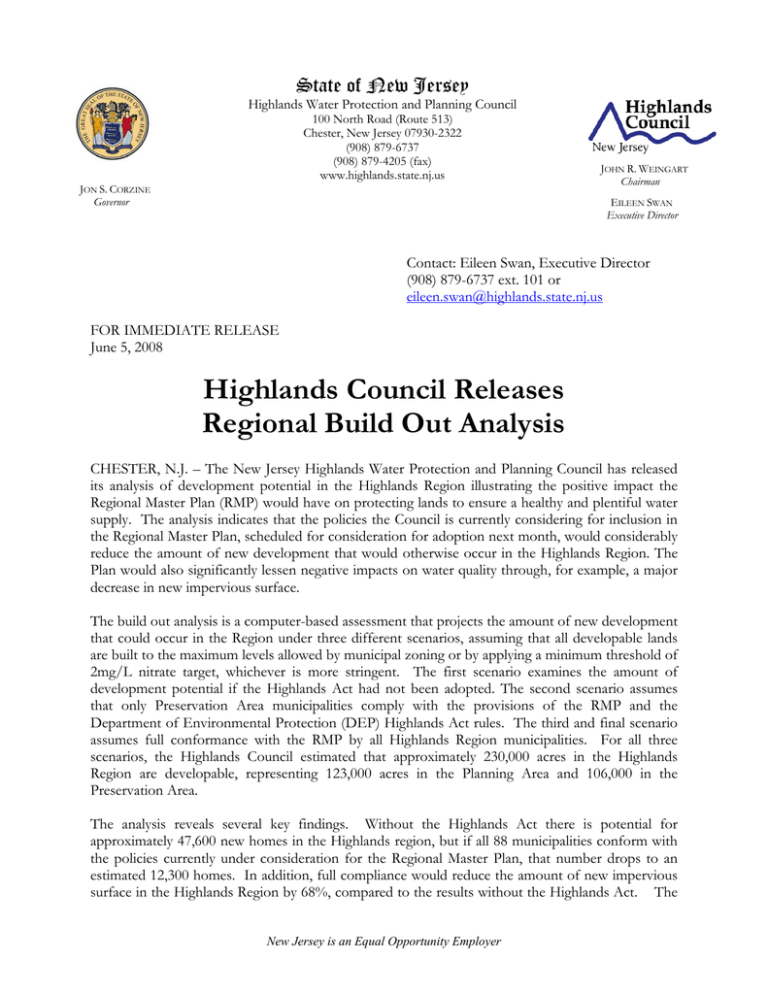
State of New Jersey Highlands Water Protection and Planning Council 100 North Road (Route 513) Chester, New Jersey 07930-2322 (908) 879-6737 (908) 879-4205 (fax) www.highlands.state.nj.us JON S. CORZINE Governor JOHN R. WEINGART Chairman EILEEN SWAN Executive Director Contact: Eileen Swan, Executive Director (908) 879-6737 ext. 101 or eileen.swan@highlands.state.nj.us FOR IMMEDIATE RELEASE June 5, 2008 Highlands Council Releases Regional Build Out Analysis CHESTER, N.J. – The New Jersey Highlands Water Protection and Planning Council has released its analysis of development potential in the Highlands Region illustrating the positive impact the Regional Master Plan (RMP) would have on protecting lands to ensure a healthy and plentiful water supply. The analysis indicates that the policies the Council is currently considering for inclusion in the Regional Master Plan, scheduled for consideration for adoption next month, would considerably reduce the amount of new development that would otherwise occur in the Highlands Region. The Plan would also significantly lessen negative impacts on water quality through, for example, a major decrease in new impervious surface. The build out analysis is a computer-based assessment that projects the amount of new development that could occur in the Region under three different scenarios, assuming that all developable lands are built to the maximum levels allowed by municipal zoning or by applying a minimum threshold of 2mg/L nitrate target, whichever is more stringent. The first scenario examines the amount of development potential if the Highlands Act had not been adopted. The second scenario assumes that only Preservation Area municipalities comply with the provisions of the RMP and the Department of Environmental Protection (DEP) Highlands Act rules. The third and final scenario assumes full conformance with the RMP by all Highlands Region municipalities. For all three scenarios, the Highlands Council estimated that approximately 230,000 acres in the Highlands Region are developable, representing 123,000 acres in the Planning Area and 106,000 in the Preservation Area. The analysis reveals several key findings. Without the Highlands Act there is potential for approximately 47,600 new homes in the Highlands region, but if all 88 municipalities conform with the policies currently under consideration for the Regional Master Plan, that number drops to an estimated 12,300 homes. In addition, full compliance would reduce the amount of new impervious surface in the Highlands Region by 68%, compared to the results without the Highlands Act. The New Jersey is an Equal Opportunity Employer June 5, 2008 Page 2 build out analysis also indicates that, without the Highlands Act, 27% of the projected water demand and 15% of the wastewater utility demand could not be supported by the relevant watershed and utilities. Additionally, the analysis suggests that much of the undeveloped land currently zoned for commercial and industrial use is in environmentally constrained areas, outside of existing water and sewer service areas. As such, based on current population and infrastructure conditions, the development of many of these commercial and industrial lands is highly unlikely and does not reflect smart growth principles. Most importantly, the analysis indicates that the RMP policies when fully implemented in the Highlands Region allow for resource protection and smart growth development that is protective of Highlands’s water quality and quantity. John Weingart, Highlands Council Chairman, stated “The results of the build out analysis clearly demonstrate that the RMP we are currently considering will profoundly reduce the amount of new development that would have occurred without the Act. Of equal importance, the Plan enables the Council, working in conjunction with the Region’s municipalities and counties to ensure that the new development that does take place is guided to the most appropriate locations and uses state-ofthe art environmental design and construction techniques.” Weingart added, “The analysis we are releasing today shows that the Highlands Plan will not be a prescription for no further growth, but will be, as I believe the Legislature intended, a very restrictive, regional master plan that respects and protects the water resources and other environmental attributes of the Highlands.” The analysis conducted by the Highlands Council relies on extensive new and existing data that will benefit from further analysis and refinement over time. “The Highlands Council will work with municipalities during the RMP conformance process as they perform local build out analyses that will better reflect local conditions that cannot be assessed at a regional level.” Eileen Swan, Executive Director, explained, “The Highlands Council is fully committed to partnering with our municipalities to refine the build out analysis by drawing upon their knowledge and experience concerning local circumstances.” Of the 88 Highlands municipalities, 73 have #####
